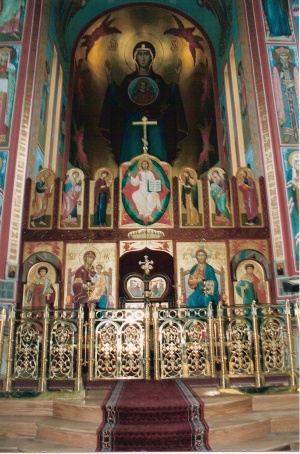Difference between revisions of "Panagia Platytera"
(formatting, added image, ext. links) |
|||
| Line 1: | Line 1: | ||
| − | '''Panagia Platytera''' ( | + | [[Image:St Nick DC Altar.jpg|thumb|right|This Panagia Platytera icon rises above the [[iconostasis]] in [[St. Nicholas Cathedral (Washington, D.C.)|St. Nicholas Cathedral, Washington, DC]]]] |
| + | '''Panagia Platytera''' (Greek: Πλατυτέρα; "wider" or "more spacious") is an [[icon]] of the [[Theotokos]], facing the viewer directly, usually depicted full length with her hands in the "[[orans]]" position, and with the image of [[Christ]] as a child in front of her chest, also facing the viewer directly. Sometimes the image of Christ is contained within a medallion. | ||
| + | Poetically, by containing the Creator of the Universe in her womb, Mary has become ''Platytera ton ouranon'', which means: "More spacious than the heavens." This type is sometimes called the "Virgin of the Sign" or "Our Lady of the Sign," a reference to [[Book of Isaiah|Isaiah]] 7:14: "Therefore the Lord himself shall give you a sign; Behold, a virgin shall conceive, and bear a son, and shall call his name Emmanuel." | ||
| + | |||
| + | Such an image is often placed in the [[apse]] above the [[altar]]. | ||
<!--- | <!--- | ||
==History of the icon== | ==History of the icon== | ||
| Line 6: | Line 10: | ||
==List of monasteries== | ==List of monasteries== | ||
---> | ---> | ||
| − | + | ==External links== | |
| − | ==External | + | *[http://www.insidemani.gr/fresco.html Panagia Platytera fresco] in Mani, Greece |
| − | [http://www.insidemani.gr/fresco.html | + | *[[w:Our Lady of the Sign|''Our Lady of the Sign'' at Wikipedia]] |
| + | *[http://www.rollins.edu/Foreign_Lang/Russian/panagia.html The Virgin Orans Great Panagia] | ||
{{stub}} | {{stub}} | ||
Revision as of 16:51, February 1, 2008
Panagia Platytera (Greek: Πλατυτέρα; "wider" or "more spacious") is an icon of the Theotokos, facing the viewer directly, usually depicted full length with her hands in the "orans" position, and with the image of Christ as a child in front of her chest, also facing the viewer directly. Sometimes the image of Christ is contained within a medallion.
Poetically, by containing the Creator of the Universe in her womb, Mary has become Platytera ton ouranon, which means: "More spacious than the heavens." This type is sometimes called the "Virgin of the Sign" or "Our Lady of the Sign," a reference to Isaiah 7:14: "Therefore the Lord himself shall give you a sign; Behold, a virgin shall conceive, and bear a son, and shall call his name Emmanuel."
Such an image is often placed in the apse above the altar.
External links
- Panagia Platytera fresco in Mani, Greece
- Our Lady of the Sign at Wikipedia
- The Virgin Orans Great Panagia
Categories > Arts
Categories > Arts
Categories > Church Life > Theotokonymia
Categories > Church Life > Theotokonymia > Icons of the Theotokos
Categories > Images > Icons
Categories > Liturgics > About Icons
Categories > Liturgics > About Icons
Categories > Liturgics > Feasts
Categories > Liturgics > Feasts
Categories > OrthodoxWiki > Stubs
